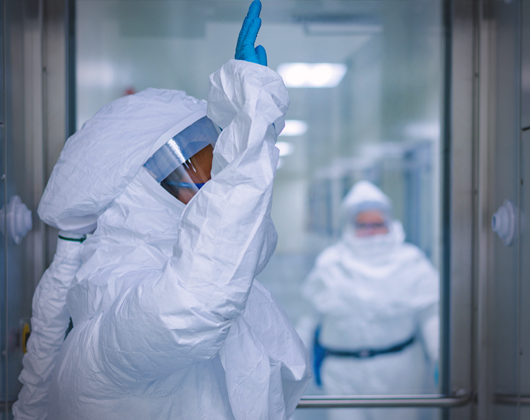High-potency active pharmaceutical ingredients (HPAPIs) are becoming increasingly common in drug development pipelines. This is especially the case in the oncology sector as researchers look for therapies with greater selectivity and pharmacological activity. However, HPAPIs present additional chemistry, manufacturing, and controls (CMC) challenges due to the containment required to protect both operators and manufacturing facilities. Production processes may also require greater precision and control due to the very small quantities of drug present in the final dosage form. For drug developers, working with a contract development and manufacturing organization (CDMO) that has a long track record of successfully handling HPAPIs is essential.
With over 30 years of experience in small-molecule drug development, Quotient Sciences possesses the expertise to overcome the challenges that arise with HPAPIs. Our facilities are configured with the necessary engineering controls for handling and processing HPAPIs. We offer our customers an end-to-end development solution, from early-phase formulation screening through to clinical and commercial manufacturing.
This article discusses why it is important to classify HPAPIs and how they are evaluated, how HPAPI facilities are qualified, and strategies to ensure containment and safety when handling HPAPIs.
Why is it important to classify HPAPIs?
The concept of Acceptable Workplace Exposure Levels (AWELs) and Occupational Exposure Limits (OELs) is based on the premise that workers who are handling material may be exposed to a defined level of chemical substances without significantly increasing the risk of adverse health effects. The maximum concentration for this exposure is based on the known toxicological characteristics of the compound in question. When an exposure limit is established, workplace controls must be designed to achieve the appropriate level of containment in order to ensure adequate protection of employees.
In recent years, a number of systems have been proposed for categorizing drug substances according to their potency, based on the use of OELs or Occupational Exposure Banding (OEB) systems. The basis for the development of these systems in the pharmaceutical industry was for the prevention of adverse health effects when working with active pharmaceutical ingredients (APIs).
The concept of the Performance-Based Level of Exposure Classification (PBLEC) system is based on establishing controls determined by the hazards and risks posed by handling specific compounds. These compounds do not usually have an AWEL or OEL established. The PBLEC concept of control strategies gives the necessary guidance to achieve the desired level of containment or control. Engineering controls are the primary method of control to ensure employee safety. Further administrative and personal protective equipment (PPE) controls are secondary and tertiary controls, respectively.
New drugs in the early stages of development often have very little safety data available, making classification difficult for the Environmental, Health, and Safety (EHS) professional. The PBLEC guideline allows the EHS professional to categorize compounds that have very little safety data in order to estimate their toxicity.
How are HPAPIs evaluated?
At Quotient Sciences, the 5-band PBLEC system is used. Each PBLEC band covers a range of airborne concentrations of substances in an 8-hour time-weighted average (TWA). In our facilities, we can handle PBLEC1 compounds (OEL >1000 µg/m3) through to PBLEC5 compounds (OEL ≥0.1 μg/m3) depending on the type of drug product and batch size required. PBLEC1 compounds have low pharmacological activity and are considered relatively safe to handle. PBLEC5 compounds are extremely toxic and/or have very high pharmacological activity. At Quotient Sciences, PBLEC4 compounds are considered highly potent and PBLEC5 compounds are considered extremely potent. Both require handling with specified HPAPI controls.
The factors considered when classifying a compound include AWELs or OELs for structurally related compounds, pharmacological class/activity, mutagenicity, carcinogenicity, and reproductive toxicity.
At Quotient Sciences, the PBLEC system is applied independently to analytical, formulation development, and manufacturing operations. The three areas have individualized strategies outlined for personnel working with the APIs. These include containment of the compounds, personal protection, training, disposal, signage, ventilation, and industrial/occupational hygiene monitoring.
How are HPAPI facilities and engineering controls qualified?
Surrogate monitoring or control performance target (CPT) testing is used to assess the suitability of Quotient Sciences’ HPAPI manufacturing suites and engineering controls. This testing is conducted using a non-potent powder (e.g. sodium naproxen) with a high dustiness quotient and challenging electrostatic properties to mimic the API. The purpose of this testing is to simulate operating conditions and prove the effectiveness of the engineering controls/facility design.
How do you ensure containment and safety when handling HPAPIs?
To handle HPAPIs safely, manufacturing practices have moved away from reliance on PPE alone, with current practices focusing on “containment at source” to prevent operator exposure. This is achieved through the effective use of engineering controls (e.g. local exhaust ventilation (LEV) devices, full hard-shell or flexible containment, and closed transfer systems). The type of engineering control required is dependent on the PBLEC category of the API and the risk of operator exposure to inhalable powder particles from the manufacturing process.
In addition to the primary engineering controls, to ensure containment at source, other facility designs (e.g. air change rates, high-efficiency particulate air (HEPA) filtration, airlocks) and administrative controls (e.g. safe methods of working, operator training) are employed. PPE that is appropriate to the task is also required.
Containment strategies may differ slightly in the laboratory compared to the manufacturing area due to the lower quantity of API being handled (i.e. milligram compared to kilogram scale), but the same principles of operator protection are employed.
Summary
Quotient Sciences has invested heavily in specialized facilities in both the UK and the US to provide the necessary containment, engineering controls, and personnel protection needed to safely handle HPAPIs and to prevent cross-contamination. Our state-of-the-art manufacturing facilities have undergone multiple EHS audits to ensure that they meet current Good Manufacturing Practice (cGMP) standards and have been inspected by several major global regulatory agencies. Our risk-management program includes ongoing EHS monitoring and surrogate testing to ensure consistent control over our processes, facilities, cleaning procedures, and standard operating procedures (SOPs).
To find out more about Quotient Sciences’ HPAPI handling capabilities, click here.
